Bicontinuous Cubic and Hexagonal Columnar Liquid Crystalline Ion-Conductors at Room Temperature in Ion-Doped Dendritic Amphiphiles
Abstract
1. Introduction
2. Materials and Methods
2.1. General Methods
2.2. Synthesis
2.2.1. Synthesis of 4,4’-(5-Bromo-1,3-Phenylene) Bis (1-(3,4,5-Tris ((3,7-Dimethyloctyl) Oxy) Phenyl) -1H-1,2,3-Triazole) (B2-1)
2.2.2. Synthesis of 4-(3,5-Bis(1-(3,4,5-Tris((3,7-Dimethyloctyl) Oxy) Phenyl)-1H-1,2,3-Triazol-4-yl) Phenyl) -2-Methylbut-3-Yn-2-ol (B2-2)
2.2.3. Synthesis of 4,4’-(5-Ethynyl-1,3-Phenylene) bis (1-(3,4,5-Tris ((3,7-Dimethyloctyl) Oxy) Phenyl) -1H-1,2,3-Triazole) (B2-3)
2.2.4. Synthesis of 4,4’-(5-(1-(3,4,5-Tris(2-(2-(2-Methoxyethoxy) Ethoxy) Ethoxy) Benzyl)-1H- 1,2,3-Triazol-4-yl)-1,3-Phenylene) bis (1-(3,4,5-Tris((3,7-Dimethyloctyl) Oxy) Phenyl)-1H-1,2,3-Triazole) (AB2)
2.2.5. Preparation of the Ionic Samples
3. Results
3.1. Thermotropic Properties
3.2. Ion-Conducting Properties Using Impedance Analysis
4. Conclusions
Author Contributions
Funding
Acknowledgments
Conflicts of Interest
References
- Kato, T. Self-Assembly of Phase-Segregated Liquid Crystal Structures. Science 2002, 295, 2414–2418. [Google Scholar] [CrossRef] [PubMed]
- Hamley, I.W. Nanotechnology with Soft Materials. Angew. Chem. Int. Ed. 2003, 42, 1692–1712. [Google Scholar] [CrossRef] [PubMed]
- Song, J.; Cho, B.-K. Non-Tortuous Ionic Transport in Robust Micellar Liquid Crystalline Phases with Cubic Symmetry. Chem. Commun. 2012, 48, 6821–6823. [Google Scholar] [CrossRef] [PubMed]
- Yoshio, M.; Mukai, T.; Ohno, H.; Kato, T. One-Dimensional Ion Transport in Self-Organized Columnar Ionic Liquids. J. Am. Chem. Soc. 2004, 126, 994–995. [Google Scholar] [CrossRef]
- Yoshio, M.; Kagata, T.; Hoshino, K.; Mukai, T.; Ohno, H.; Kato, T. One-Dimensional Ion-Conductive Polymer Films: Alignment and Fixation of Ionic Channels Formed by Self-Organization of Polymerizable Columnar Liquid Crystals. J. Am. Chem. Soc. 2006, 128, 5570–5577. [Google Scholar] [CrossRef]
- Shimura, H.; Yoshio, M.; Hoshino, K.; Mukai, T.; Ohno, H.; Kato, T. Noncovalent Approach to One-Dimensional Ion Conductors: Enhancement of Ionic Conductivities in Nanostructured Columnar Liquid Crystals. J. Am. Chem. Soc. 2008, 130, 1759–1765. [Google Scholar] [CrossRef]
- Soberats, B.; Yoshio, M.; Ichikawa, T.; Zeng, X.; Ohno, H.; Ungar, G.; Kato, T. Ionic Switch Induced by a Rectangular–Hexagonal Phase Transition in Benzenammonium Columnar Liquid Crystals. J. Am. Chem. Soc. 2015, 137, 13212–13215. [Google Scholar] [CrossRef]
- Shimura, H.; Yoshio, M.; Hamasaki, A.; Mukai, T.; Ohno, H.; Kato, T. Electric-Field-Responsive Lithium-Ion Conductors of Propylenecarbonate-Based Columnar Liquid Crystals. Adv. Mater. 2009, 21, 1591–1594. [Google Scholar] [CrossRef]
- Yoshio, M.; Mukai, T.; Kanie, K.; Yoshizawa, M.; Ohno, H.; Kato, T. Layered Ionic Liquids: Anisotropic Ion Conduction in New Self-Organized Liquid-Crystalline Materials. Adv. Mater. 2002, 14, 351–354. [Google Scholar] [CrossRef]
- Ohtake, T.; Ogasawara, M.; Ito-Akita, K.; Nishina, N.; Ujiie, S.; Ohno, H.; Kato, T. Liquid-Crystalline Complexes of Mesogenic Dimers Containing Oxyethylene Moieties with LiCF3SO3: Self-Organized Ion Conductive Materials. Chem. Mater. 2000, 12, 782–789. [Google Scholar] [CrossRef]
- Eisele, A.; Kyriakos, K.; Bhandary, R.; Schönhoff, M.; Papadakis, C.M.; Rieger, B. Structure and Ionic Conductivity of Liquid Crystals Having Propylene Carbonate Units. J. Mater. Chem. A 2015, 3, 2942–2953. [Google Scholar] [CrossRef]
- Lee, J.H.; Han, K.S.; Lee, J.S.; Lee, A.S.; Park, S.K.; Hong, S.Y.; Lee, J.-C.; Mueller, K.T.; Hong, S.M.; Koo, C.M. Facilitated Ion Transport in Smectic Ordered Ionic Liquid Crystals. Adv. Mater. 2016, 28, 9301–9307. [Google Scholar] [CrossRef] [PubMed]
- Soberats, B.; Uchida, E.; Yoshio, M.; Kagimoto, J.; Ohno, H.; Kato, T. Macroscopic Photocontrol of Ion-Transporting Pathways of a Nanostructured Imidazolium-Based Photoresponsive Liquid Crystal. J. Am. Chem. Soc. 2014, 136, 9552–9555. [Google Scholar] [CrossRef] [PubMed]
- Sakuda, J.; Hosono, E.; Yoshio, M.; Ichikawa, T.; Matsumoto, T.; Ohno, H.; Zhou, H.; Kato, T. Liquid-Crystalline Electrolytes for Lithium-Ion Batteries: Ordered Assemblies of a Mesogen-Containing Carbonate and a Lithium Salt. Adv. Funct. Mater. 2014, 25, 1206–1212. [Google Scholar] [CrossRef]
- Kouwer, P.H.J.; Swager, T.M. Synthesis and Mesomorphic Properties of Rigid-Core Ionic Liquid Crystals. J. Am. Chem. Soc. 2007, 129, 14042–14052. [Google Scholar] [CrossRef] [PubMed]
- Concellón, A.; Liang, T.; Schenning, A.P.H.J.; Serrano, J.L.; Romero, P.; Marcos, M. Proton-Conductive Materials Formed by Coumarin Photocrosslinked Ionic Liquid Crystal Dendrimers. J. Mater. Chem. C 2018, 6, 1000–1007. [Google Scholar] [CrossRef]
- Kerr, R.L.; Miller, S.A.; Shoemaker, R.K.; Elliott, B.J.; Gin, D.L. New Type of Li Ion Conductor with 3D Interconnected Nanopores via Polymerization of a Liquid Organic Electrolyte-Filled Lyotropic Liquid-Crystal Assembly. J. Am. Chem. Soc. 2009, 131, 15972–15973. [Google Scholar] [CrossRef]
- Choi, J.-W.; Cho, B.-K. Degree of Chain Branching-Dependent Assemblies and Conducting Behavior in Ionic Liquid Crystalline Janus Dendrimers. Soft Matter 2011, 7, 4045–4049. [Google Scholar] [CrossRef]
- Ichikawa, T.; Yoshio, M.; Hamasaki, A.; Taguchi, S.; Liu, F.; Zeng, X.; Ungar, G.; Ohno, H.; Kato, T. Induction of Thermotropic Bicontinuous Cubic Phases in Liquid-Crystalline Ammonium and Phosphonium Salts. J. Am. Chem. Soc. 2012, 134, 2634–2643. [Google Scholar] [CrossRef]
- Kobayashi, T.; Ichikawa, T.; Kato, T.; Ohno, H. Development of Glassy Bicontinuous Cubic Liquid Crystals for Solid Proton-Conductive Materials. Adv. Mater. 2017, 29, 1604429. [Google Scholar] [CrossRef]
- Ichikawa, T.; Kato, T.; Ohno, H. 3D Continuous Water Nanosheet as a Gyroid Minimal Surface Formed by Bicontinuous Cubic Liquid-Crystalline Zwitterions. J. Am. Chem. Soc. 2012, 134, 11354–11357. [Google Scholar] [CrossRef] [PubMed]
- Ichikawa, T.; Sasaki, Y.; Kobayashi, T.; Oshiro, H.; Ono, A.; Ohno, H. Design of Ionic Liquid Crystals Forming Normal-Type Bicontinuous Cubic Phases with a 3D Continuous Ion Conductive Pathway. Crystals 2019, 9, 309. [Google Scholar] [CrossRef]
- Ichikawa, T.; Yoshio, M.; Hamasaki, A.; Mukai, T.; Ohno, H.; Kato, T. Self-Organization of Room-Temperature Ionic Liquids Exhibiting Liquid-Crystalline Bicontinuous Cubic Phases: Formation of Nano-Ion Channel Networks. J. Am. Chem. Soc. 2007, 129, 10662–10663. [Google Scholar] [CrossRef] [PubMed]
- Ichikawa, T.; Yoshio, M.; Hamasaki, A.; Kagimoto, J.; Ohno, H.; Kato, T. 3D Interconnected Ionic Nano-Channels Formed in Polymer Films: Self-Organization and Polymerization of Thermotropic Bicontinuous Cubic Liquid Crystals. J. Am. Chem. Soc. 2011, 133, 2163–2169. [Google Scholar] [CrossRef]
- Onuma, T.; Hosono, E.; Takenouchi, M.; Sakuda, J.; Kajiyama, S.; Yoshio, M.; Kato, T. Noncovalent Approach to Liquid-Crystalline Ion Conductors: High-Rate Performances and Room-Temperature Operation for Li-Ion Batteries. ACS Omega 2018, 3, 159–166. [Google Scholar] [CrossRef]
- Nguyen, M.L.; Kim, H.-J.; Cho, B.-K. Ionic effects on the self-assembly, molecular dynamics and conduction properties of a 1,2,3-triazole-based amphiphile. J. Mater. Chem. C 2018, 6, 9802–9810. [Google Scholar] [CrossRef]
- Kim, J.; Cho, S.; Cho, B.-K. An unusual stacking transformation in liquid-crystalline columnar assemblies of clicked molecular propellers with tunable light emissions. Chem. Eur. J. 2014, 20, 12734–12739. [Google Scholar] [CrossRef]
- Choi, J.-W.; Cho, B.-K. Mesomorphic and Conducting Properties of Dendritic-Linear Copolymers via Ion-Doped Additives. J. Polym. Sci. Part A Polym. Chem. 2011, 49, 2468–2473. [Google Scholar] [CrossRef]
- Choi, J.-W.; Ryu, M.-H.; Lee, E.; Cho, B.-K. Ion-Induced Bicontinuous Cubic and Columnar Liquid-Crystalline Assemblies of Discotic Block Codendrimers. Chem. Eur. J. 2010, 16, 9006–9009. [Google Scholar] [CrossRef]
- Kölbel, M.; Beyersdorff, T.; Tschierske, C.; Diele, S.; Kain, J. Thermotropic and Lyotropic Liquid Crystalline Phases of Rigid Aromatic Amphiphiles. Chem. Eur. J. 2000, 6, 3821–3837. [Google Scholar] [CrossRef]
- Beltrán, E.; Serrano, J.L.; Sierra, T.; Giménez, R. Functional Star-Shaped Tris(triazolyl)triazines: Columnar Liquid Crystal, Fluorescent, Solvatofluorochromic and Electrochemical Properties. J. Mater. Chem. 2012, 22, 7797–7805. [Google Scholar] [CrossRef]
- Beltrán, E.; Serrano, J.L.; Sierra, T.; Giménez, R. Tris(triazolyl)triazine via Click-Chemistry: A C3 Electron-Deficient Core with Liquid Crystalline and Luminescent Properties. Org. Lett. 2010, 12, 1404–1407. [Google Scholar] [CrossRef] [PubMed]
- Sakamoto, N.; Hashimoto, T. Order−Order and Order−Disorder Transitions in a Polystyrene-block-Polyisoprene-block-Polystyrene Copolymer. Macromolecules 1997, 30, 1621–1632. [Google Scholar] [CrossRef]
- Nguyen, M.L.; Shin, T.J.; Kim, H.-J.; Cho, B.-K. Oriented Columnar Films of a Polar 1,2,3-Triazole-Based Liquid Crystal Prepared by Applying an Electric Field. J. Mater. Chem. C 2017, 5, 8256–8265. [Google Scholar] [CrossRef]
- Chung, Y.-W.; Lee, J.-K.; Zin, W.-C.; Cho, B.-K. Self-Assembling Behavior of Amphiphilic Dendron Coils in the Bulk Crystalline and Liquid Crystalline States. J. Am. Chem. Soc. 2008, 130, 7139–7147. [Google Scholar] [CrossRef]
- Kirsch, C.; Pulst, M.; Samiullah, M.H.; Ruda, P.; Hasan, N.; Kressler, J. 1,2,3-Triazole mediated Li+-ion conductivity in poly(ethylene oxide) based electrolytes. Solid State Ionics 2017, 309, 163–169. [Google Scholar] [CrossRef]
- Massarotti, A.; Aprile, S.; Mercalli, V.; Grosso, E.D.; Grosa, G.; Sorba, G.; Tron, G.C. Are 1,4- and 1,5-Disubstituted 1,2,3-Triazoles Good Pharmacophoric Groups? ChemMedChem 2014, 9, 2497–2508. [Google Scholar] [CrossRef]
- Dias, F.B.; Batty, S.V.; Voss, J.P.; Ungar, G.; Wright, P.V. Ionic Conductivity of a Novel Smectic Polymer Electrolyte. Solid State Ion. 1996, 85, 43–49. [Google Scholar] [CrossRef]
- Liu, J.; Zheng, Y.; Liao, Y.-P.; Zeng, X.; Ungar, G.; Wright, P.V. Organisation in Two Series of Low-Dimensional Polymer Electrolytes with High Ambient Lithium Salt Conductivity. Faraday Discuss. 2005, 128, 363–378. [Google Scholar] [CrossRef]
- Sangeetha, R.S.D.; Arasu, P.T.; Hirankumar, G.; Bella, R.S.D. Analysis of Dielectric, Modulus, Electrochemical Stability of PVP-ABSA Polymer Electrolyte Systems. Int. J. Chem. Sci. 2016, 14, 477–481. [Google Scholar]
- Pradhan, D.K.; Choudhary, R.N.P.; Samantaray, B.K. Studies of Dielectric Relaxation and AC Conductivity Behavior of Plasticized Polymer Nanocomposite Electrolytes. Int. J. Electrochem. Sci. 2008, 3, 597–608. [Google Scholar]
- Starkweather, H.W.; Avakian, P. Conductivity and the Electric Modulus in Polymers. J. Polym. Sci. Part B Polym. Phys. 1992, 30, 637–641. [Google Scholar] [CrossRef]
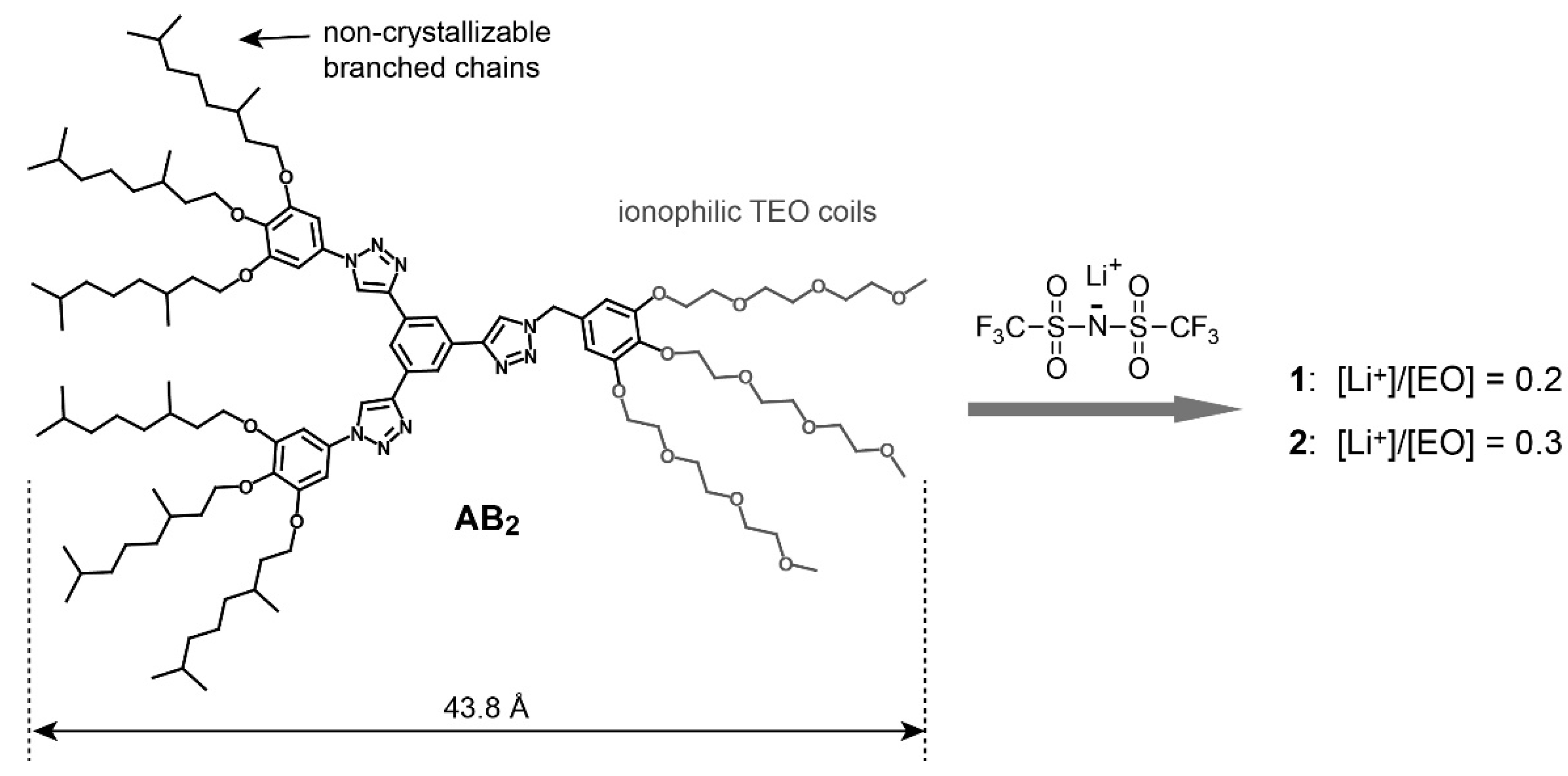
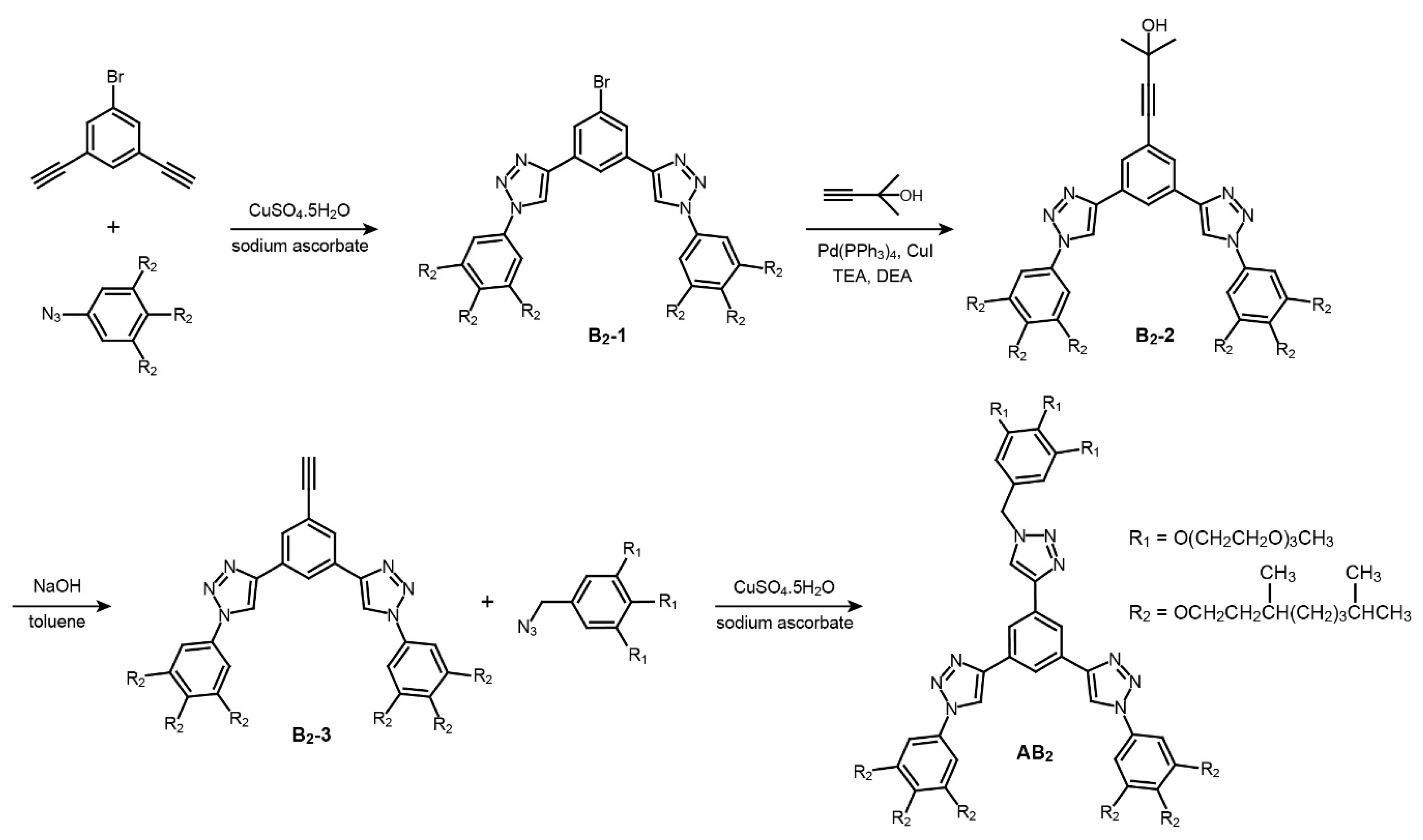
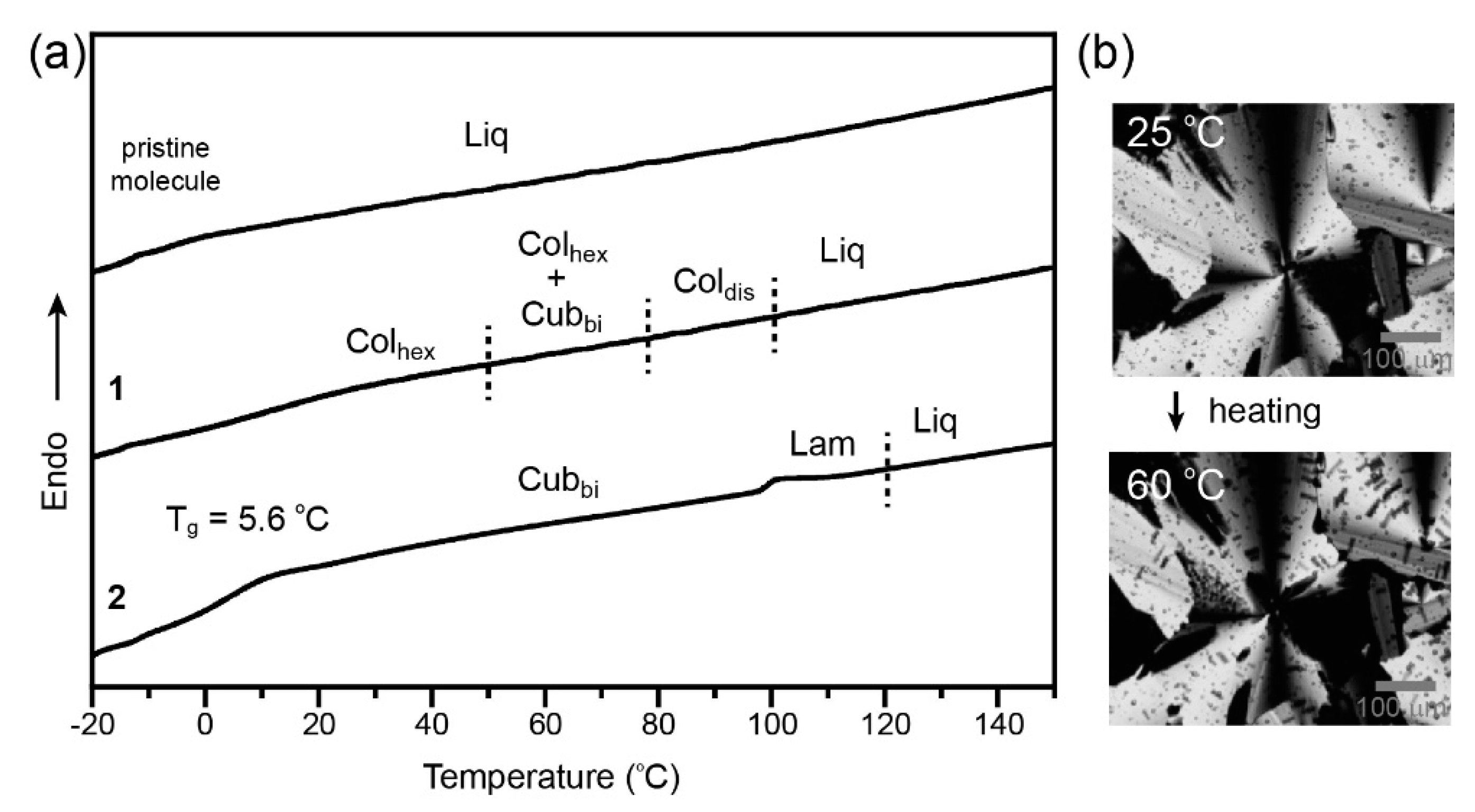
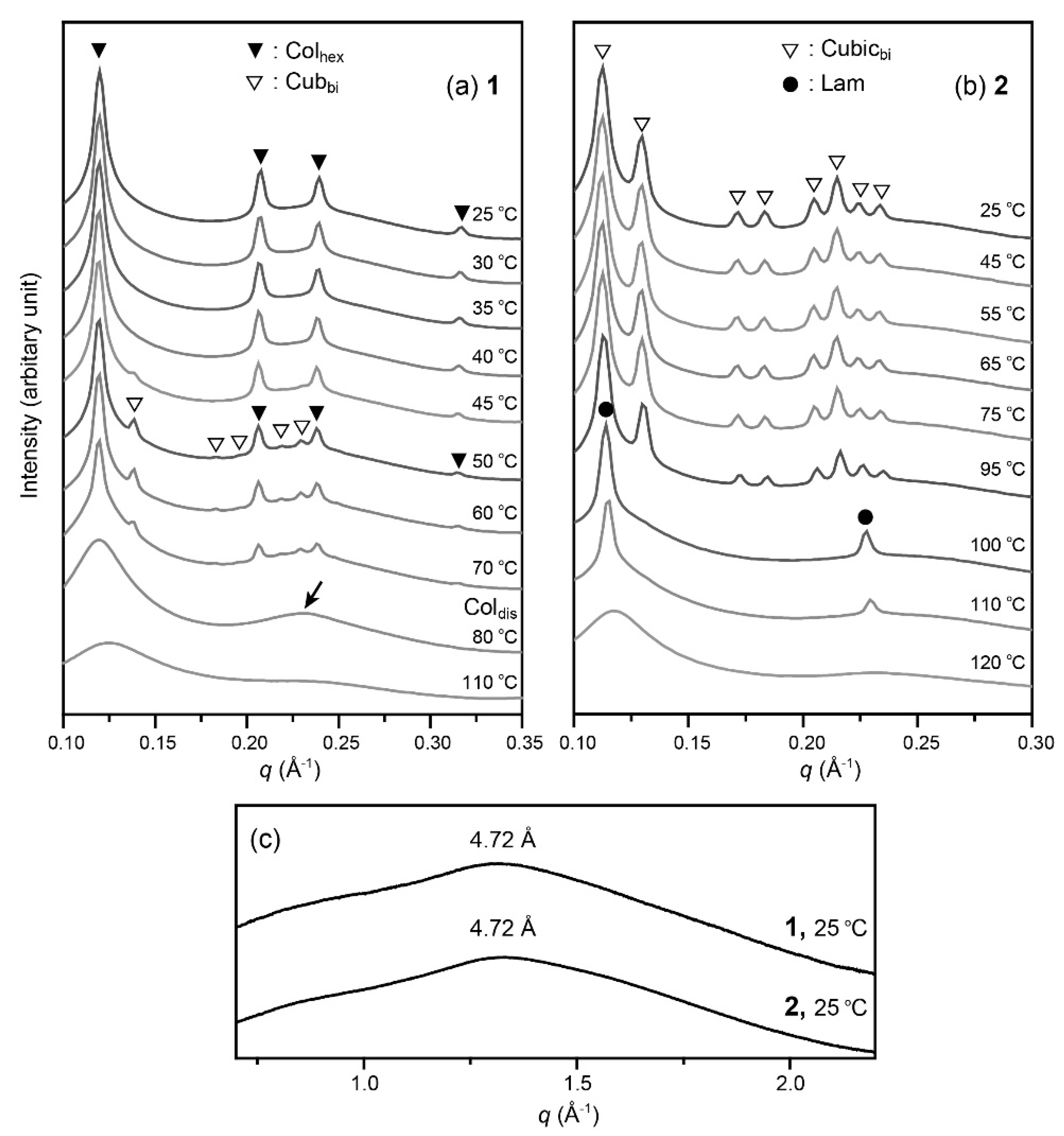
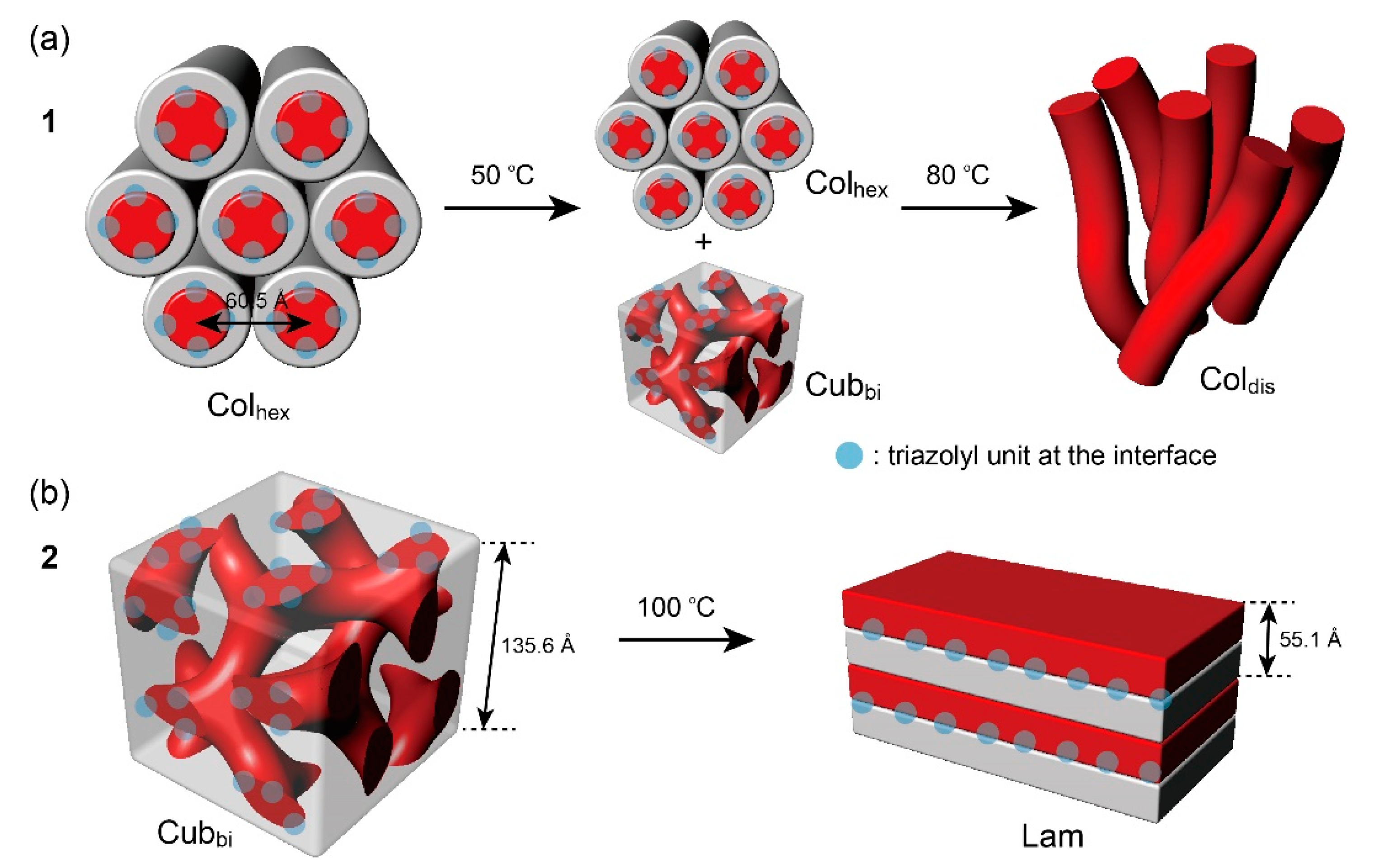

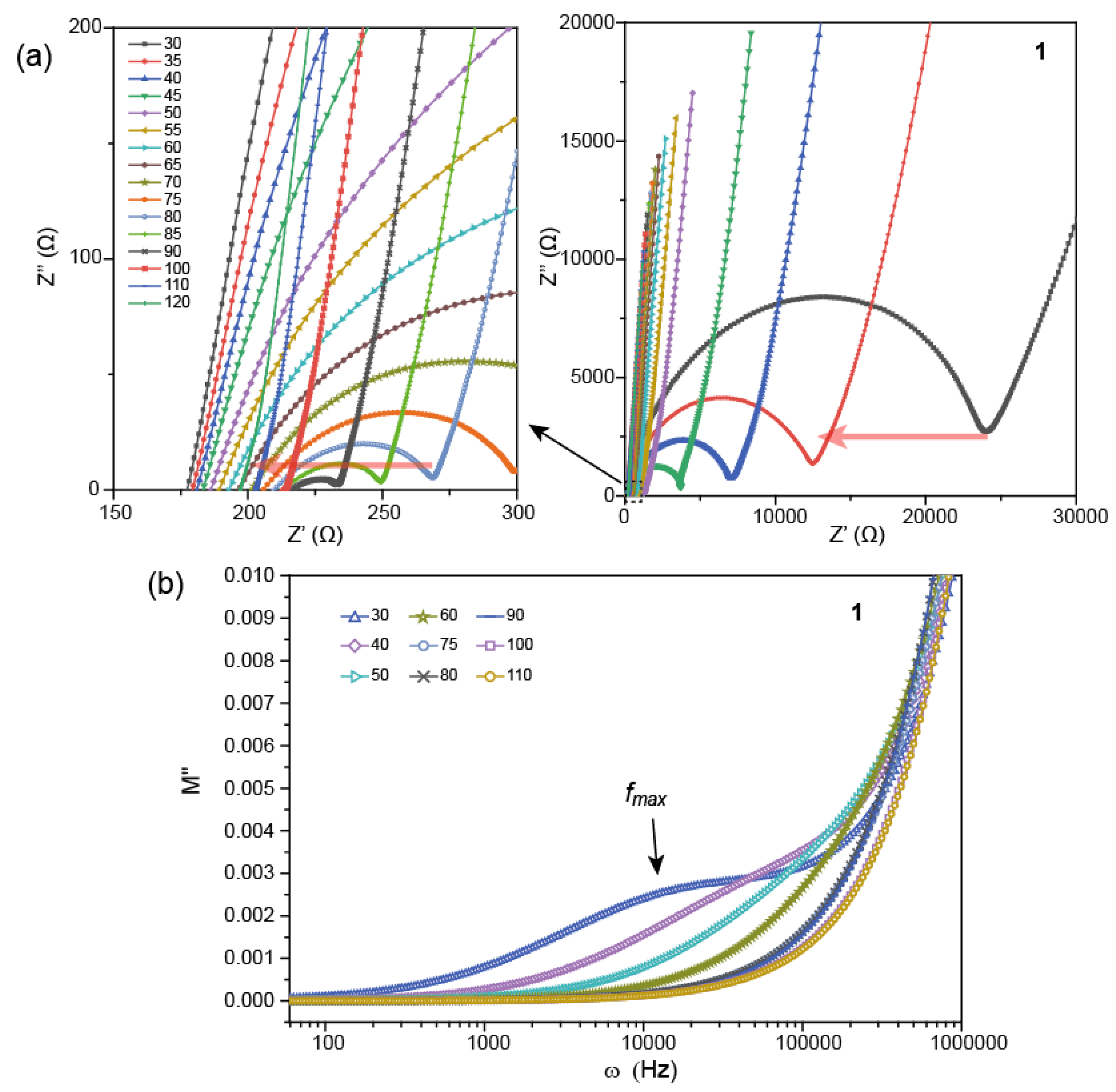
© 2020 by the authors. Licensee MDPI, Basel, Switzerland. This article is an open access article distributed under the terms and conditions of the Creative Commons Attribution (CC BY) license (http://creativecommons.org/licenses/by/4.0/).
Share and Cite
Do, T.H.; Kim, H.-J.; Nguyen, M.L.; Cho, B.-K. Bicontinuous Cubic and Hexagonal Columnar Liquid Crystalline Ion-Conductors at Room Temperature in Ion-Doped Dendritic Amphiphiles. Crystals 2020, 10, 193. https://doi.org/10.3390/cryst10030193
Do TH, Kim H-J, Nguyen ML, Cho B-K. Bicontinuous Cubic and Hexagonal Columnar Liquid Crystalline Ion-Conductors at Room Temperature in Ion-Doped Dendritic Amphiphiles. Crystals. 2020; 10(3):193. https://doi.org/10.3390/cryst10030193
Chicago/Turabian StyleDo, Thi Huyen, Ho-Joong Kim, Manh Linh Nguyen, and Byoung-Ki Cho. 2020. "Bicontinuous Cubic and Hexagonal Columnar Liquid Crystalline Ion-Conductors at Room Temperature in Ion-Doped Dendritic Amphiphiles" Crystals 10, no. 3: 193. https://doi.org/10.3390/cryst10030193
APA StyleDo, T. H., Kim, H.-J., Nguyen, M. L., & Cho, B.-K. (2020). Bicontinuous Cubic and Hexagonal Columnar Liquid Crystalline Ion-Conductors at Room Temperature in Ion-Doped Dendritic Amphiphiles. Crystals, 10(3), 193. https://doi.org/10.3390/cryst10030193




